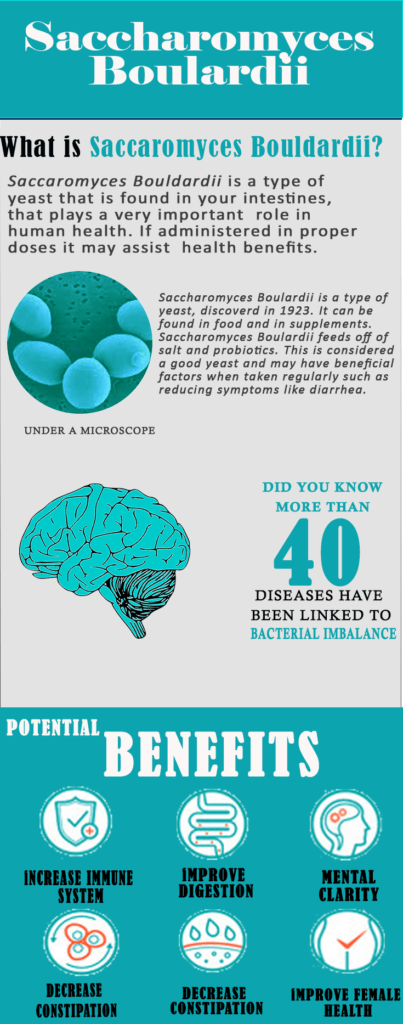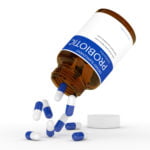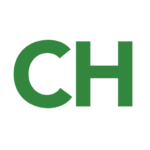Medically Reviewed
Probiotics are made of microorganisms like yeast or bacteria and they aim to promote overall health by improving digestion. Saccharomyces boulardii, also referred to as S. boulardii and pronounced SAK-a-roe-MYE-sees-boo-LAR-dee, is a yeast found naturally in tropical plants.
What is Saccharomyces Boulardii?
Saccharomyces boulardii is sometimes used as a probiotic, and can be found in probiotic supplements, with the purpose of improving the overall health of the human intestinal tract. It also serves to provide protection to the intestinal walls by adhering to them, and blocking out harmful bacteria. Particularly proven to be found effective is S. boulardii.
Studies have shown that
Discovery
Saccharomyces Boulardii was originally discovered in 1923 by French microbiologist Henri Boulard. Boulard was working in Indochina when he observed that locals consumed tea made with the tropical fruits lychee and mangosteen to ward off diarrhea caused by
Following the discovery of S.
Where is it Found?
Saccharomyces
Saccharomyces Boulardii Medical Effects On The Human Body
Treatment of Antibiotic-Associated Diarrhea
Various studies have found
- A randomized controlled trial conducted by The Medical University of Warsaw found that patients who took saccharomyces
boulardii orally had a lower prevalence of diarrhea during and up to two weeks after treatment. The researchers concluded thatsaccharomyces boulardii “effectively reduces the risk of antibiotic‐associateddiarrhoea in children.”[37] - A systematic review and meta-analysis on
saccharomyces boulardii in adult patients found evidence thatsaccharomyces boulardii reduced the side effects of H. pylori treatment and prevented enteral nutrition-related diarrhea. This study also found that it is “significantly effective” for treating adult acute diarrhea and traveler’s diarrhea. [40]
Treatment of Diarrhea Related to Illnesses
There have been several studies that show Saccharomyces boulardii may be helpful in treating diarrhea caused by other illnesses such as:
Clostridium
Acute gastroenteritis: Further studies support the benefit of S. boulardii in the reduction of antibiotic-associated diarrhea in hospitalized patients, C. difficile associated diarrhea in laboratory mice and traveller’s diarrhea. [8][12][20]
Helicobacter pylori infection: The addition of probiotics is associated with improved H. pylori eradication rates in both children and adults. [42]
Traveler’s diarrhea: anytime a person travels they may experience an upset stomach and diarrhea. This yeast may help in the reduction of symptoms.[19]
Crohn’s Disease[5][6]
C-diff infections[8–12][20]
Maintenance Treatment of Disease
For therapeutic treatment of clostridium difficile: in a randomized placebo-controlled trial, researchers found that saccharomyces boulardii was “shown to be an effective and safe therapy for these patients with recurrent CDD(c. difficile)”.[35]
Another study conducted in rats found that
Maintenance treatment of Crohn’s disease: a study on patients with Crohn’s disease discovered preliminary data showing that saccharomyces boulardii could be effective in the maintenance treatment of the disease.[36]

Top 4 killers of Saccharomyces Boulardii
- Probiotics need to be protected in enteric-coated capsules for them to be able to reach and populate the lower intestine. [1]
- Tap Water: unfortunately, tap water isn’t great for yeast growth. It can reduce, slow or possibly stop growth altogether.[2]
- Hot or cold temperatures: yeast grows best in warm to very warm temperatures. Although it can survive a wide range of temperatures, it begins to suffer
injury at temperatures of 120 degrees Fahrenheit and will likely lose all life by 140 degrees Fahrenheit. Freezing will put the yeast in a state of suspension.[3] - Starvation: Yeast needs both food and salt to grow. If yeast does not have these nutrients, it will not thrive.
How Safe is it?
Saccharomyces boulardii has been found to have very minimal risk. Saccharomyces boulardii is likely safe for adults to take orally. In rare cases in subjects with weakened immune systems or in pregnant women, it may cause fungal infections that can spread through the body, as well as into the bloodstream. [18] If for whatever reason you have a weakened immune system, or for women who are pregnant/breastfeeding, caution should be used and you should consult with your physician before taking probiotics, as the side effects in these individuals are not fully known yet.
Saccharomyces
Who Should Avoid Use of Saccharomyces Boulardii?
People with yeast allergies: people with yeast allergies should avoid use of saccharomyces boulardii unless advised otherwise by a physician. Saccharomyces boulardii can cause allergic reactions in these individuals.[34]
People suffering from weakened immune systems: fungemia is an infection that occurs when a yeast infection spreads to the bloodstream. People who are taking medications that negatively compromise the immune system or have a weakened immune system due to illness or disease should avoid taking
How to Pick the Best Saccharomyces Boulardii Supplements

- In order to reap the health benefits of saccharomyces boulardii, the supplement should have a minimum effective dose of 1 billion CFU.
- For preservation, supplements containing saccharomyces boulardii should be freeze dried. In order to ensure that they have the opportunity to populate the lower intestine, be sure the capsules are enteric coated.
- In this study researchers found that “alginate microspheres(i.e. microencapsulation) could be of great interest in therapeutic applications of the yeast.” In other words, it’s a good idea to ensure that whatever saccharomyces boulardii supplements you decide to buy are microencapsulated so that the supplement is bioavailable(meaning it lasts through to the intestinal tract and has its intended therapeutic effect) upon consumption.
- For the best results we recommend looking into a blend of probiotics that include saccharomyces boulardii, along with at least 10 strains of healthy probiotic bacteria.
- As with all supplements, it should be non-GMO, free from unnecessary fillers and binders, and made in a cGMP certified facility in the USA.
- Probiotic supplements should be purchased from company you’ve researched and trust. Legitimate probiotic supplement vendors have simple, straight forward return policies.
- Any high-quality supplements will be be made in a cGMP certified facility so you know they’ve been grown in sanitary conditions.

How to get the most out of your supplements
- Choose your supplements from a reputable company.
- Follow the directions on the label and take the recommended dosage.
- Avoid taking probiotics on an empty stomach.
- Store probiotics properly – in most cases that means in a cool, dry place.
- Probiotics work best when taken in addition to a healthy diet. Probiotics are able to flourish best when they’re combined with fruits, vegetables and foods rich in fiber.
Want to Learn More?
Here are some more helpful resources on saccharomyces boulardii:
Sources
[expand title=”Show Sources”]
- https://link.springer.com/article/10.1007/s11095-007-9528-5
- https://link.springer.com/article/10.1007/s11095-007-9528-5
- https://undergradsciencejournals.okstate.edu/index.php/jibi/article/view/2512
- https://www.kingarthurflour.com/learn/yeast-bread-primer.html
- https://undergradsciencejournals.okstate.edu/index.php/jibi/article/view/2512
- https://link.springer.com/article/10.1023%2FA%3A1005588911207?LI=true
- http://europepmc.org/abstract/med/8465554
- http://www.sciencedirect.com/science/article/pii/0016508589916132
- https://jamanetwork.com/journals/jama/article-abstract/375521?redirect=true
- http://www.sciencedirect.com/science/article/pii/001650859390280P
- https://academic.oup.com/cid/article/31/4/1012/372121
- http://iai.asm.org/content/67/1/302.short
- https://www.optibacprobiotics.co.uk/uploads/surawicz_et_al_(1989)_treatment_of_recurrent_clostridium_difficile_colitis_with_vancomycin_and_saccharomyces_boulardii_optibac_probiotics_www.optibacprobiotics.co.uk.pdf
- http://journals.lww.com/eurojgh/Abstract/2003/06000/A_pilot_trial_of_Saccharomyces_boulardii_in.17.aspx
- https://www.researchgate.net/profile/Lynne_Mcfarland/publication/15327512_Prevention_of_-lactam-associated_diarrhea_by_Saccharomyces_boulardii_compared_to_placebo/links/53f78b4c0cf24ddba7d8a3ea/Prevention-of-lactam-associated-diarrhea-by-Saccharomyces-boulardii-compared-to-placebo.pdf
- http://onlinelibrary.wiley.com/doi/10.1111/j.1365-2036.2005.02356.x/full
- https://www.medscimonit.com/abstract/index/idArt/448924/new/1/act/3
- http://journals.lww.com/jcge/Abstract/2003/01000/Saccharomyces_cerevisiae_Fungemia_After.13.aspx
- https://www.ncbi.nlm.nih.gov/pmc/articles/PMC3296087/
- http://europepmc.org/abstract/med/8486328
- http://iai.asm.org/content/69/4/2762.short
- https://www.nature.com/articles/pr1994782
- http://www.sciencedirect.com/science/article/pii/S1286457902015927
- https://www.nature.com/articles/pr198646
- http://onlinelibrary.wiley.com/doi/10.1002/bdd.2510100403/full
- http://www.sciencedirect.com/science/article/pii/S0378378203000902
- http://www.sciencedirect.com/science/article/pii/S0006291X06003810
- http://www.ajtmh.org/content/journals/10.4269/ajtmh.2008.78.214
- http://iai.asm.org/content/68/10/5998.short
- https://www.ncbi.nlm.nih.gov/pmc/articles/PMC4125647/
- http://journals.lww.com/jpgn/citation/1995/07000/fungemia_with_saccharomyces_boulardii_in_a.22.aspx
- http://www.foodsforliving.com/ns/DisplayMonograph.asp?storeID=f491b142fa784f2cbdf1e053a643a6a7&DocID=bottomline-sboulardii
- https://link.springer.com/article/10.1007/s11095-007-9528-5
- https://medlineplus.gov/druginfo/natural/332.html
- https://jamanetwork.com/journals/jama/article-abstract/375521?redirect=true
- https://link.springer.com/article/10.1023/A:1005588911207
- https://onlinelibrary.wiley.com/doi/full/10.1111/j.1365-2036.2005.02356.x
- https://www.sciencedirect.com/science/article/pii/001650859390280P
- https://onlinelibrary.wiley.com/doi/full/10.1111/j.1365-2036.2007.03442.x
- https://www.ncbi.nlm.nih.gov/pmc/articles/PMC2868213/
- https://wholefoodsmagazine.com/supplements/features-supplements/saccharomyces-boulardii-probiotic-yeast/
- https://www.dovepress.com/probiotics-improve-the–efficacy-of-standard-triple-therapy-in-the-era-peer-reviewed-fulltext-article-IDR
[/expand]
